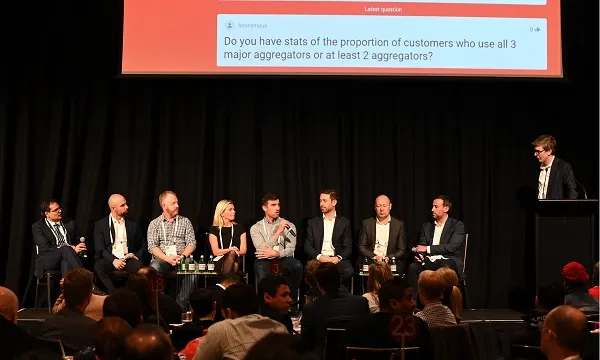
The next big steps for ordering and what they mean for your brand
Aggregators, industry leaders, and tech experts weigh in on the evolution of ordering in the digitized world.
In the perspective of convenience, being a consumer has never been easier. Innovations in restaurant ordering have broken countless barriers with the introduction of tech like mobile apps, augmented reality, and machine learning, giving consumers the benefits of a seamless, frictionless ordering experience.
This new, digital ecosystem has all but engulfed the QSR industry, from the state-of-the-art in-store kiosks, mobile payment options, third-party aggregators and voice recognition.
The trend towards the convenience of faster, seamless ordering can be observed throughout the industry. Julian Casa, National Marketing Manager of Baskin-Robbins Australia, explained at the QSR Media Sandhurst Fine Foods Conference & Awards 2019 that through the adoption of mobile payments alone, consumers can be seen changing their demands towards personalized, convenient experiences.
“Consumers are evolving in terms of creating frictionless transactions. In our experience certainly has been a great acceptance of mobile payments,” he said.
“The old adage of cash is dead may not be so relevant. But certainly there's a much more broad acceptance from our consumer base in relation to mobile payments, and over time, it is possible using that technology can allow you to personalize an incredible experience.”
Whether through third-party delivery apps or through their own in-house mobile app, using technology can help brands analyze consumer data and curate a user experience that can create loyal, repeat customers.
“Nowadays customers expect a completely seamless ordering experience. Therefore what we're finding is that personalizing everything we can is super important. Because customers just expect to be able to get through the experience as easily as possible; gone are the days when people are willing to scroll through lists and lists of content to find what they want, now they expect to only see content that is relevant to them and they want it to be presented to them in an intuitive way,” Matt Gillam, Director of Technology at Menulog, said.
Gillam added that one of the key things aggregators could do is share insights with restaurant partners and chains about customer behavior across the whole market, in order to help them identify market opportunities and optimise their services.
Sue Savage, Director of Strategic and Major Accounts JAPAC at Oracle Food and Beverage, agreed.
“Beyond the technology is that consumers no longer just want to order from you. They want their favorites from you. And they will select providers that can give them their favorites faster than those that require you to punch in an order from scratch. That's becoming the expectation rather than the exception. So customers and operators who choose to integrate loyalty data to ordering platforms we're finding are much more successful in the market and retaining their customers and uplifting their digital channels,” she said.
Chirag Tejuja, co-Founder of TabSquare, pointed out that brands can use this demand for convenience to their advantage.
“The idea is that today's customer wants things fast, he wants a lot of content to make decisions. But at the same time, he wants to be directed to things that he likes to order. Essentially, the idea is how do you get them to order things that what they like, but at the same time make a higher margin for your restaurant,” he said.
Using tech to get customers back in stores
For brands who are running their own digital platforms, the challenge becomes how consumers can be convinced to trade data about their preferences in exchange for custom tailored services.
Christian McGilloway, Chief Technical Innovation Officer at Retail Zoo, suggested that brands come up with unique content exclusive to their own platforms, such as campaigns, promotions, and discounts.
“Whether it's through our own app, either through a website, or through social media, we offer massive discounts directed at the customer,” he said.
Essentially, he said digital platforms and even those of delivery aggregators are simply another avenue to interact with consumers and build loyalty.
Russell Schulman, Head of Marketing & eCommerce of Krispy Kreme Australia, said that the digital experience was more about letting customers interact with a business.
“It’s about letting the customers direct us as to what we use and which way we should keep investing,” he said. He added that it’s important for brands to maintain a culture that is willing to experiment and fail to find new ways of succeeding in the age of digital ordering.
“It’s about getting the balance of using online delivery as part of a holistic strategy, not getting too caught up in that, and getting people back into the stores, allowing them to shop with us how they want. We’ve invested millions of dollars into those stores, and we really want people interacting with that experience and making the interaction as seamless as possible.”
Levi Aron, then-Country Manager at Deliveroo, said that delivery platforms are in a great position to help restaurants achieve that objective.
“It’s not delivery or aggregators versus restaurants. What we look at now and the fact of the matter is that a lot of people are exploring on our app and finding restaurants that they have actually never physically been in, or are ordering from for the very first time,” he said.
Deliveroo, he said, is actively encouraging consumers to explore restaurants in-store with special in-app promotions.
“It's up to the store then whether to upsell them, or bring them onto their loyalty program. But we believe in dine in. And we believe in dine out. If the customers are going to be doing all of it, we need to work cohesively with our partners to make that happen,” he said.
Gillam added that one of the key things aggregators could do is share insights with restaurant partners and chains about customer behavior across not just in that particular kind of store channel, but across whole parts of the market.
For TabSquare, Tejuja said that a partnership between restaurants and third-party platforms can work to align the operations of both parties to achieve certain objectives.
“Data being the centerpiece of which we work on, what we end up doing is having a team of account managers who actually work together with the restaurants to define the objectives, what they want to achieve through the data, in terms of increasing sales, getting customers back. And through the mechanism of how the menu is designed by customer and how the engine works, we are able to work on those objectives together,” he said.
“The endgame of all of this is that there's convenience coming to the customer to be able to identify themselves. To that convenience, there is data flowing through in terms of his ordering history and ordering preferences. Once that ordering history and preferences are captured it's about what the learning is done to that. So, again, that experience is personalized. Everybody talks about data, which is very important. But the idea, of course, is that how the data can be used to be able to eventually affect and increase sales.”
McGilloway pointed out that conversations around the responsible use of data and data privacy have made people wary of companies having access to their data. But he observed that so long as companies are not abusing consumer data, many are content to exchange personal data for convenience.
“People say they want to have their data protected, but then they also want to have high personalization. They go and they share every single thing about themselves online. Obviously, you can’t be the Cambridge Analytica, where you share that data. But I think people and users are okay with you having that data,” he said.
“The operators I see that really want to own their customer experience. They want their customer data… because that's how they can grow that customer spend in their business. The most successful adopters of digital technology grow on the customer experience, and they do that, collecting the data.”
Aron noted that as data is crucial in the development of the industry moving forward, it is important to have conversations with consumers and QSRs about the responsible use of personal data.
Savage said that technology will continue to change the industry landscape indefinitely, with the trend of dark kitchens-- restaurants that sell exclusively through digital delivery platforms-- in Asia being predicted to make its way to Australia. Brands therefore must be proactive with the adoption of technology if they want to remain relevant.
“One of the things we're seeing in Asia is the advent of literal apartments being built without kitchens. There's a lot of dark kitchen technology out there. Operators have no choice but to be digital,” she said.
“There's a little bit of a fear to adopt new tech technology. Don't be afraid to fail. You're going to make mistakes. So take risks, build it in your budget for some innovation and some creativity. Nothing is going to be perfect the first time you try it. So look at your partners, there's a lot of companies in the room here today that that deliver technology that are willing to work with you, and willing to work with each other. Because we're all in this together.”

























